Donald Trump targets North Korea, crime gangs; unveils ‘four pillars’ of immigration limits, claims he has saved coal
Donald Trump has claimed to have saved ‘beautiful, clean coal’ though coal consumption in the US hit a new low.
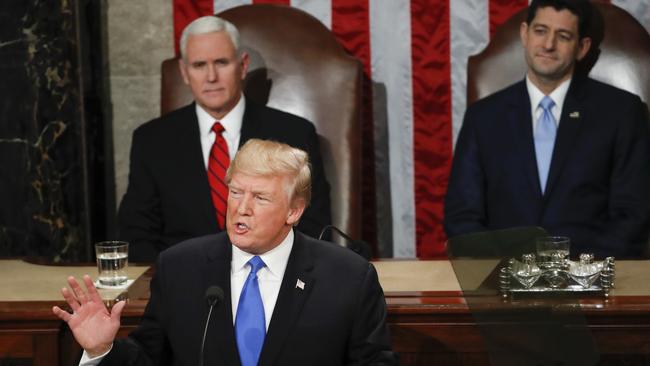
President Donald Trump has delivered his first State of the Union address, to a joint session of the US Congress in Washington. Read highlights of the speech below.
Key points
• ‘The best speech of Trump’s presidency’
• ‘Four-pillar’ immigration crackdown revealed
• Plans for $1.5 trillion in infrastructure spending
• The President plans to keep Guantanamo Bay open
• Fact-checking the State of the Union address
• All eyes have been on Melania Trump today
6.55pm: Trump the champion of ‘clean coal’
President Trump proclaimed he had ended the war on ‘clean coal’ but US coal consumption actually dropped 2.4 per cent during the first year of his presidency.
“We have ended the war on American energy, and we have ended the war on beautiful clean coal,” Trump declared during his first State of the Union address. “We are now proudly an exporter of energy to the world.”
Pres. Trump: “We have ended the war on American energy—and we have ended the war on beautiful, clean coal.†https://t.co/wdGSMPKty8 #SOTU pic.twitter.com/Wq2lYC9TJC
— ABC News (@ABC) January 31, 2018
Long ago Trump announced his intent to leave the Paris climate change agreement in 2020. His administration has also repealed the Clean Power Plan regulation on carbon emissions from existing power plants that underpinned the international climate accord.
Coal has seen its prospects improve modestly during Trump’s first year. Driven by exports, US coal production increased by six per cent last year and coal jobs in the US increased by 1 per cent due to increased demand in Asia.
However despite the growth in exports, US.coal consumption declined by 2.4 per cent in 2017, falling to its lowest level since 1982.
Coal’s portion of the electricity generation mix, which was near 50 per cent a decade ago, is projected to fall below 30 per cent in 2018, the US Energy Information Administration said.
Which does raise the question, how exactly has Trump saved coal?
4.50pm: What the papers say
Donald Trump’s speech finished at 10.30pm local time, early enough for remaking of front pages to report on the State of the Union.
This page was updated after the first edition. Here is the final front page. pic.twitter.com/nfR7p2wEPB
— Washington Post (@washingtonpost) January 31, 2018
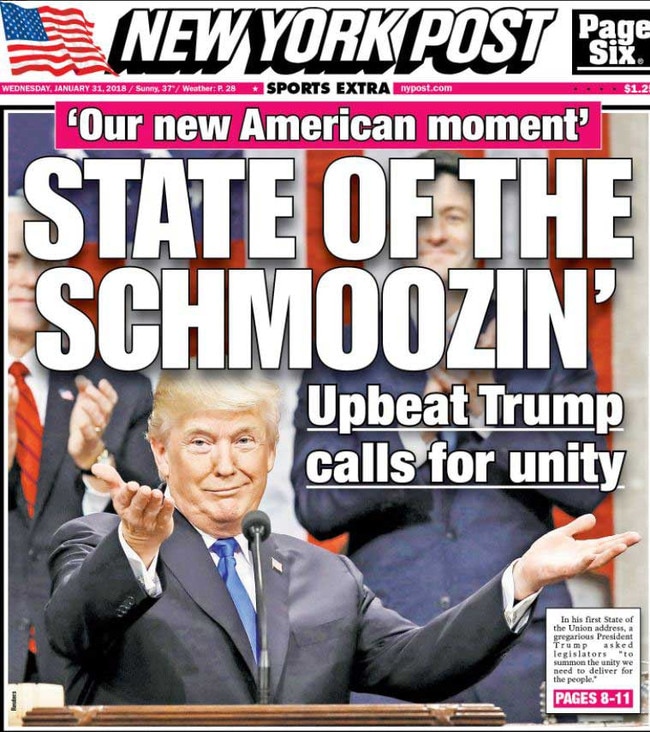
Take an early look at the front page of The Wall Street Journalhttps://t.co/5xQPDPcm8q pic.twitter.com/bFpSFJLaw5
— The Wall Street Journal (@WSJ) January 31, 2018
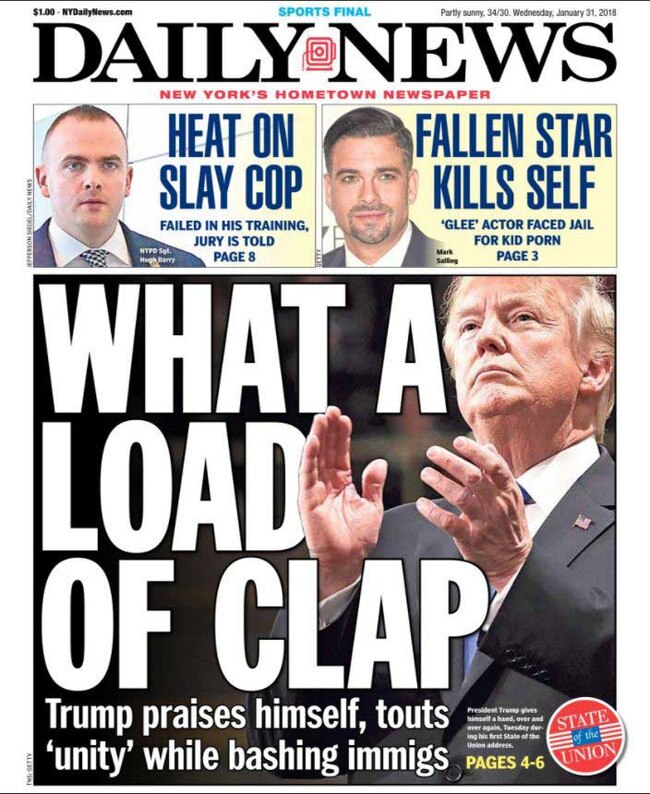
4.20pm: More reaction to Trump’s speech
Liberal icon Bernie Sanders is blasting President Donald Trump for what he did not say during his State of the Union address.
The 2016 presidential candidate noted that Trump didn’t mention Social Security or Medicare, despite promises as a candidate to protect the popular programs.
Sanders recalls Trump touting his commitment to clean air and clean water. The senator says he struggled “not to laugh out loud” in the House chamber.
Sanders is still deciding whether to run for president again in 2020.
.@POTUS said it right—the state of our union is strong. He laid out a clear agenda tonight with an open hand toward bipartisan cooperation. Together, we can continue making America safer and stronger for the 21st century. pic.twitter.com/zQi7naDVFk
— Paul Ryan (@SpeakerRyan) January 31, 2018
Tonight, @realDonaldTrump presented a self-congratulatory speech w/o vision. He promised unity, but sowed division. America deserves better. #SOTU
— Nancy Pelosi (@NancyPelosi) January 31, 2018
What a heartwarming story about the police officer and his wife who adopted the baby of the woman who was addicted to drugs. #sotu
— Scott Walker (@ScottWalker) January 31, 2018
4pm: A tribute to Otto
In a moving moment during President Trump’s speech, he commemorated Otto Warmbier while making the point about the dangers posed by North Korea.
Warmbier was sentenced to 15 years in prison with hard labor after being convicted of subversion. He tearfully confessed he had tried to steal a propaganda banner.
The University of Virginia student was held for more than 17 months and medically evacuated from North Korea. He returned with severe brain damage and died shortly after his return.
Trump recognized Warmbier’s parents during his State of the Union address. As he did so, Fred and Cindy Warmbier were moved to tears.
Trump calls them “powerful witnesses to a menace that threatens our world.”
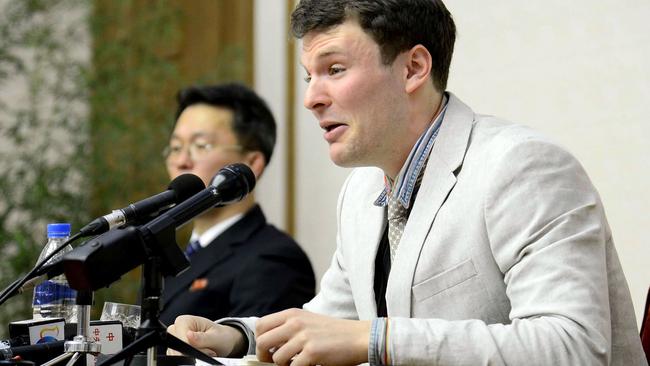
3.25pm: Democrats respond
Soaring stock prices under President Trump have boosted investor portfolios and corporate profits but failed to give workers their fair share of the reward, Joe Kennedy III said in the Democratic response to today’s State of the Union address.
Kennedy called on Americans to reject the extreme partisanship and “chaos” of the Trump era. In an apparent reference to Trump, Kennedy said “bullies may land a punch” and leave a mark but have “never managed to match the strength and spirit of a people united in defence of their future.”
In a hard-hitting speech for a political newcomer, Kennedy decried a rollback of civil rights protections, noting proposals that target Muslims, transgender people and others.
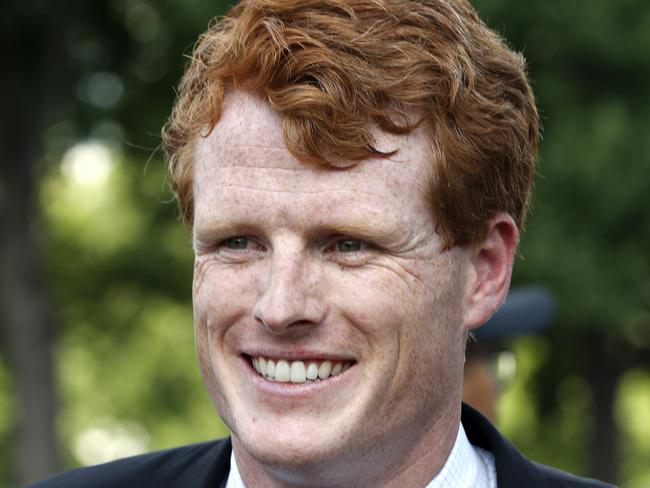
The administration “isn’t just targeting the laws that protect us - they are targeting the very idea that we are all worthy of protection,” Kennedy said in a speech from a vocational high school in Fall River, Massachusetts, a onetime manufacturing hub now struggling with high unemployment and other problems.
Kennedy, 37, a three-term congressman and grandson of former Attorney General Robert F. Kennedy, has urged Democrats to focus on the economic worries of working-class voters who bolted the party in the 2016 elections.
The selection of Kennedy, known mostly for his famous last name, has been criticised by some as tone-deaf at a time when the sexual harassment of women and the Black Lives Matter movement are at the forefront of Democratic politics. Speaking without a suit coat in front of a rebuilt car and an enthusiastic audience, Kennedy tried to defuse that Tuesday by citing the #MeToo movement and declaring, “Black lives matter.”
In a nod to “Dreamers,” the 700,000 young immigrants brought to the US as children and now here illegally, Kennedy spoke in Spanish as he said Dreamers are a part of America’s story and promised that Democrats will not walk away from them.
3.05pm: North Korean defector cheered
The biggest roar of the night was reserved for Ji Seong-ho, a Korean who is in the crowd. President Trump told Seong-ho’s story:
“In 1996, Seong-ho was a starving boy in North Korea. One day, he tried to steal coal from a railroad car to barter for a few scraps of food, which were very hard to get. In the process, he passed out on the train tracks, exhausted from hunger. He woke up as a train ran over his limbs.
“He then endured multiple amputations without anything to dull the pain or the hurt. His brother and sister gave what little food they had to help him recover and ate dirt themselves, permanently stunting their own growth.
“Later, he was tortured by North Korean authorities after returning from a brief visit to China. His tormentors wanted to know if he’d met any Christians. He had, and he resolved after that to be free.
“Seong-ho travelled thousands of miles on crutches all across China and Southeast Asia to freedom. Most of his family followed. His father was caught trying to escape and was tortured to death. Today he lives in Seoul, where he rescues other defectors, and broadcasts into North Korea what the regime fears most: the truth.
“Today he has a new leg, but Seong-ho, I understand you still keep those old crutches as a reminder of how far you’ve come. Your great sacrifice is an inspiration to us all.”
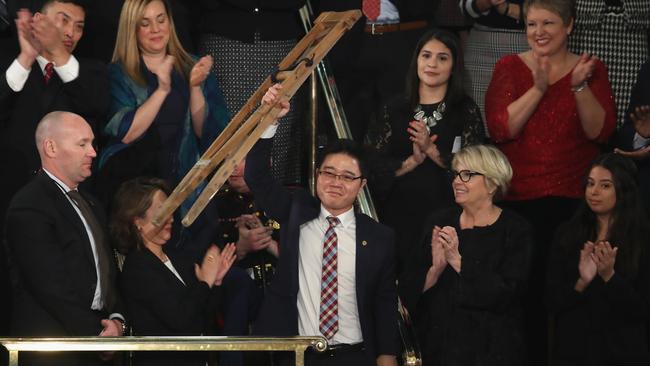
2.50pm: A lengthy stint
The President’s first State of the Union address clocked in at one hour and 20 minutes.
According to the American Presidency Project, that makes Trump’s speech one of the longest State of the Union addresses in recent presidential history. President Bill Clinton’s final State of the Union speech in January 2000 ran longer than Trump’s at just over an hour and 28 minutes.
Clinton delivered another lengthy State of the Union address - an hour and 24 minutes - in January 1995.
Trump spoke for exactly one hour last year when he addressed a joint session of Congress, but that was not a State of the Union address.
2.35pm: ‘Maximum pressure’ for North Korea
President Donald Trump says his administration is waging a “maximum pressure” campaign to prevent North Korea’s “reckless pursuit of nuclear missiles” from threatening the US homeland.
He says that threat could be a reality soon. He says past US experience with North Korea shows that “complacency and concessions only invite aggression and provocation.”
President Trump praises Ji Seong-ho, who is attending the State of the Union speech. Ji was born in North Korea and lost limbs in a train accident before defecting to South Korea, where he helps other defectors. Trump says his “great sacrifice is an inspiration to us all.”
Trump also acknowledges the parents of American college student Otto Warmbier, who died shortly after being released from detention in North Korea.
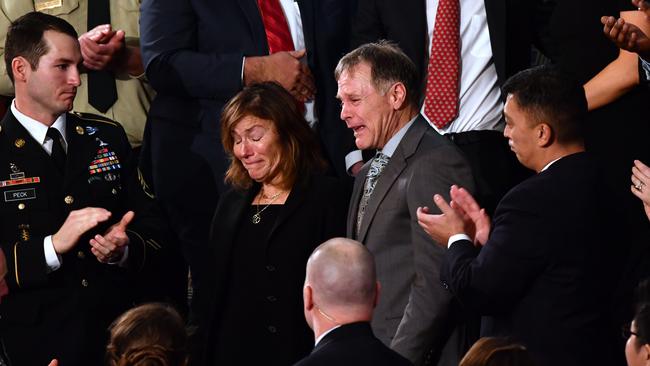
2.30pm: ‘Pillars’ of protection
President Trump outlines a “four-pillar plan” to tighten entry to America. He says drug gangs have been allowed to pour into US communities.
He highlights El Salvador’s MS-13 crime gang. “Many of these gang members took advantage of glaring loopholes and our laws to enter the country as illegal, unaccompanied, alien minors,” Trump says.
If the President wins congressional backing for his immigration plans, the four pillars will tighten what he and his populist supporters see as weak links in current law.
The first pillar, and one that might not find immediate support with the most vocal members of Trump’s anti-immigrant base, is a “path to citizenship” for undocumented migrants who arrived at a young age.
The second pillar, Trump said, “fully secures the border” by building a huge wall on the Mexican frontier and hiring more immigration agents.
The third pillar would end America’s Green Card lottery, and replace it with a so-called merit-based system for migrants with skills needed by US businesses.
And the fourth pillar -- an idea that drew protests from Democrat lawmakers during the speech, would end “chain migration” policies that allow migrants to bring in family members.
2.25pm: A warning to China and Russia
China and Russia threaten American values, President Trump declares, confirming Washington’s pivot to great power rivalry as the core of its national security policy.
“Around the world, we face rogue regimes, terrorist groups and rivals like China and Russia that challenge our interests, our economy, and our values,” Trump says.
“In confronting these dangers, we know that weakness is the surest path to conflict, and unmatched power is the surest means of our defence.”
2.20pm: Flagging intent
The President has used the story of 12-year-old Preston Sharp to drive home his case that Americans should stand for the national anthem.
Sharp organised a campaign to put flags on fallen veterans’ graves. Trump says, “Preston’s reverence for those who have served our Nation reminds us why we salute our flag, why we put our hands on our hearts for the pledge of allegiance, and why we proudly stand for the national anthem.”
Trump has hurled harsh rhetoric against football players who knelt during the national anthem to protest racism and police brutality.
Trump has said those players should be fired and called on fans to boycott their games.
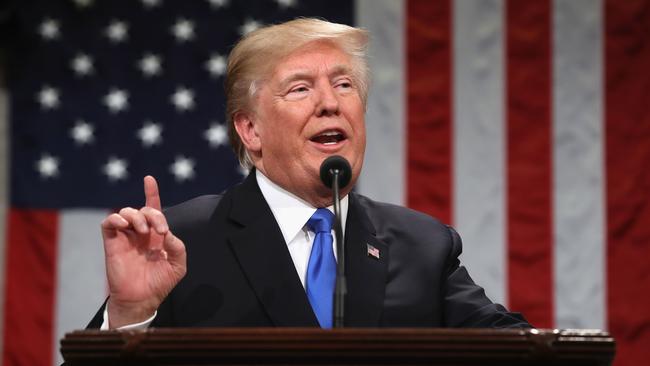
2.15pm: A war on drugs
America ultimately will prevail over a crisis that claims 174 lives daily, President Trump says. He commits the “long and difficult” fight against the epidemic of opioid and drug addiction.
Trump campaigned on the opioid issue and created a presidential advisory commission upon taking office. He recently declared the crisis a public health emergency, but the declaration did not come with additional funding.
Trump also recognised special guest Ryan Holets, an Albuquerque, New Mexico, police officer who was seated in first lady Melania Trump’s guest box. Holets and his wife adopted the baby of a pregnant, homeless woman he saw preparing to inject herself with heroin.
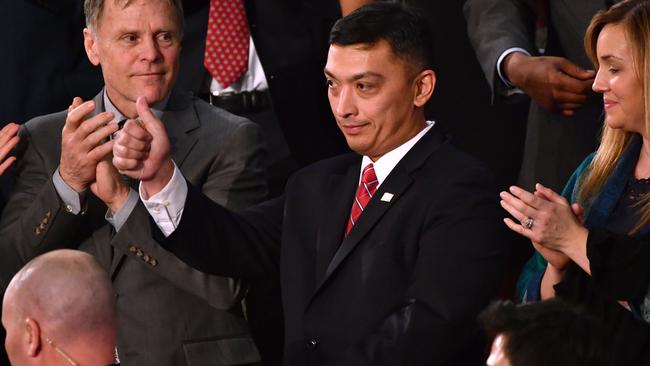
2.10pm: Message for Iran
The US President has thrown Washington’s weight behind Iranians protesting against their own government. “When the people of Iran rose up against the crimes of their corrupt dictatorship, I did not stay silent,” he declared, in implicit criticism of his predecessor’s cautious response to a 2009 protest movement.
“America stands with the people of Iran in their courageous struggle for freedom,” he said, to applause from assembled lawmakers.
2.05pm: ‘Four pillars of immigration reform’
President Trump has declared that what he calls America’s “open borders” had allowed drug gangs to pour into US communities.
Pointing out a guest -- a mother who lost two daughters to murder -- Trump urged Congress to come together to “close the loopholes” that he said allow in groups like El Salvador’s MS-13.
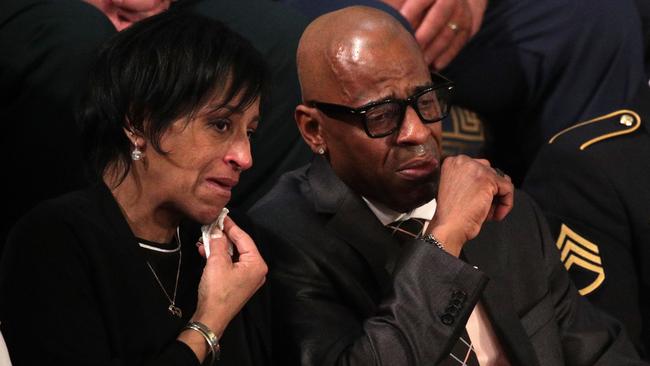
1.55pm: A $1.5 trillion plan
President Trump has called for a $1.5 trillion investment plan to renew the country’s creaking transport infrastructure.
“We will build gleaming new roads, bridges, highways, railways, and waterways across our land,” he told Congress. “And we will do it with American heart, American hands, and American grit.”
The President says every federal dollar should be leveraged by partnering with state and local governments, and tapping private-sector investment where appropriate.
Trump says an infrastructure bill must also streamline the permitting and approval process, getting it down to no more than two years and perhaps even one.
1.45pm: Melania dons Dior
First lady Melania Trump has chosen a cream-coloured Christian Dior pantsuit for her first State of the Union address as first lady.
The former fashion model paired the cropped-trouser suit with a white D&G blouse and Christian Louboutin pumps. She wore her hair loose, and flashed a bright smile.
While her husband has put forth a mantra of “America First,” Mrs Trump has mostly opted for pieces from high-end European design houses during her first year as first lady. The brands she wore Tuesday are in keeping with that custom.
Mrs Trump has not enjoyed the support from fashion designers that her predecessor did. Where former first lady Michelle Obama frequently collaborated with designers, most of Mrs. Trump’s attire is bought off-the-rack without the designer knowing the garment is destined for the first lady. “She does not concern herself with what others think about her fashion and always stays true to herself,” Stephanie Grisham, a spokeswoman for the first lady, said this year. “Mrs. Trump wears what she likes, and what is appropriate for the occasion.” Mrs. Trump made a solo entrance Tuesday and was seated next to 12-year-old activist Preston Sharp.
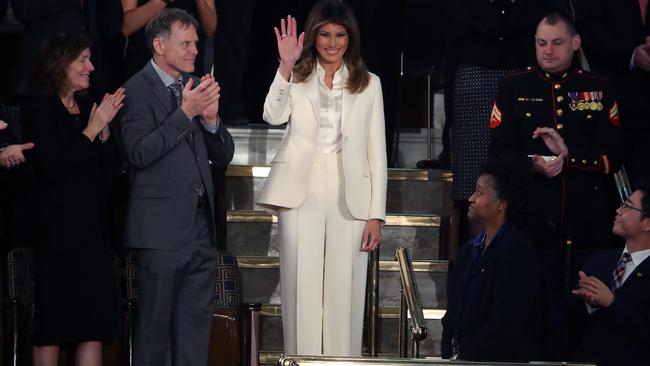
1.40pm: ‘We must look after our veterans’
Half of the House chamber is boisterous and bouncing up and down for standing ovations during President Donald Trump’s State of the Union address. The other half is sombre and still, amid a sea of black clothes.
It is as if Republicans and Democrats are attending two separate events. Republicans are applauding and cheering as Trump talks about making America great again, and his late 2017 victory revamping the tax code. Democrats are barely reacting to Trump’s remarks, though they did join in applause for emergency responders and veterans.
As Trump entered the chamber before his speech, nearly all Democrats were seated and quiet in less than 20 seconds. Democratic Republican Bill Pascrell of New Jersey waved a pocket copy of the Constitution.
"Since its passage, my Administration has already removed more than 1,500 VA employees who failed to give our veterans the care they deserve..." pic.twitter.com/vUp6Rxuaze
— The White House (@WhiteHouse) January 31, 2018
1.30pm: ‘We are building a safe America’
President Trump says the state of the union is strong “because our people are strong.” And he adds that together “we are building a safe, strong and proud America.” Trump opens his first State of the Union address by recognising the bravery of Americans who helped each other through a series of devastating hurricanes, wildfires and mass shootings during his first year in office. He also paid tribute to House Majority Whip Steve Scalise. The Louisiana Republican was severely wounded last year when a gunman opened fire on Republican lawmakers as they practised for an upcoming congressional baseball game.
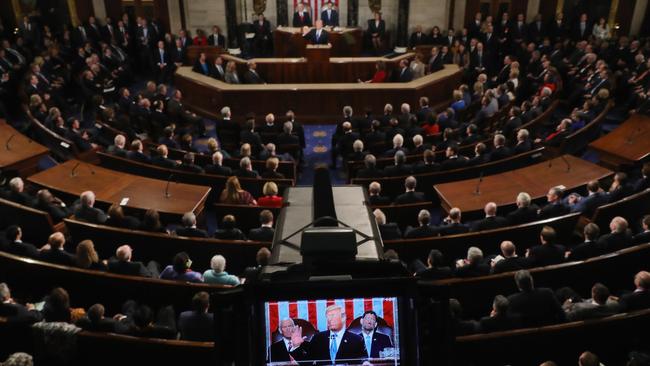
1.25pm: ‘Heights of victory, pains of hardship’
The President kicks off his State of the Union speech with recollections of the year past. He talks
about the hurricanes that devastated states including Florida and Texas, and the wildfires that ripped through Texas.
He says, “We have shared in the heights of victory and the pains of hardship.” He’s telling those affected by the devastation that “we are with you” and “we will pull through together.”
1.20pm: A call for unity
President Trump opens his State of the Union speech with call “to seek out common ground” and summon unity. He calls on Democrats, Republicans to “set aside” their differences. “The State of the Union is strong because our people are strong,” the President says.
1.15pm: Guests honoured
The first standing ovation of the night as President Trump introduces Ashlee Leppert, a Coast Guard technician who rescued dozens of people during last year’s storms during Hurricane Harvey in Texas.
Mr. Speaker, the President of the United States...#SOTU: https://t.co/nT5Y9ywiwb pic.twitter.com/4WlMzWlzS1
— The White House (@WhiteHouse) January 31, 2018
1.10pm: President Trump begins
House Speaker Paul Ryan introduces the President.
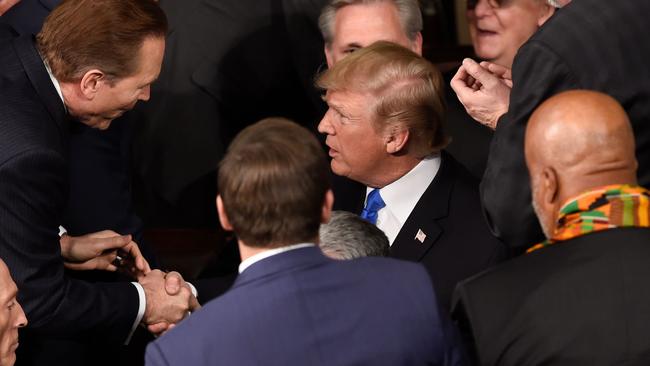
1.05pm: A rousing reception
President Trump has arrived in Congress for his speech. Handshakes, cheers and applause from Republicans and supporters.
12.50pm: Family in attendance
President Trump's son-in-law Jared Kushner and daughter Ivanka Trump are among those at Capitol Hill.
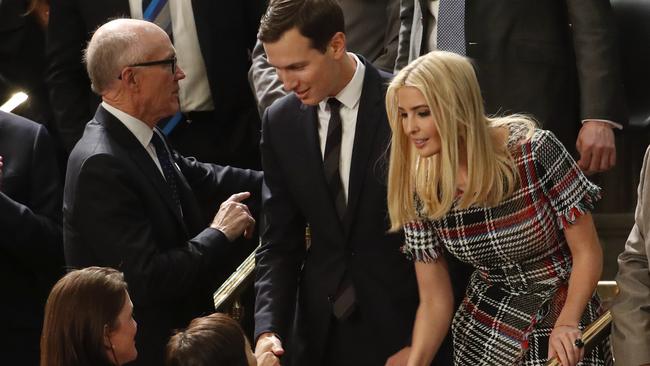
12.45pm: Melania’s break with tradition
First lady Melania Trump has travelled to Capitol Hill separately from her husband, President Donald Trump, ahead of his State of the Union speech. That’s a change from last year, when the first couple made the trip up Pennsylvania Avenue in the same vehicle.
Mrs. Trump’s spokeswoman, Stephanie Grisham, says the first lady went early, accompanying a group of guests for the speech whose stories amplify the president’s agenda. Grisham says the first lady and Karen Pence held an “intimate meet-and-greet” at the Capitol for the guests. A White House official says Mrs. Trump is expected to ride back to the White House with her husband after the speech.
Mrs Trump hadn’t been seen in public with her husband since The Wall Street Journal reported this month that in 2016, Trump’s lawyer paid porn star Stormy Daniels $130,000 to keep quiet about an affair she said she had with the future president. Daniels on Tuesday issued a statement denying the affair happened.
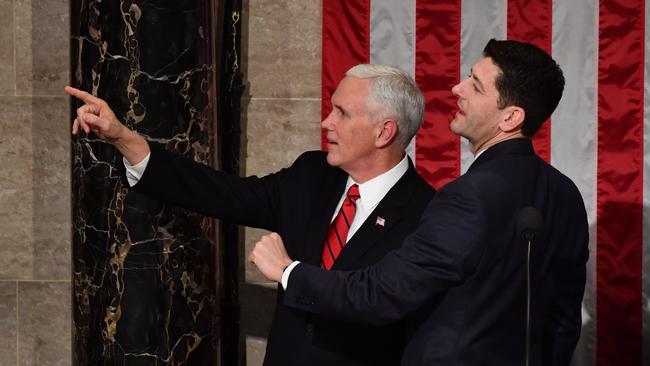
12.30pm: ‘Dreamers’ in the audience
Many congressional Democrats are giving their guest passes for President Trump’s address to young immigrants known as “Dreamers,” who were brought to the US illegally as children. More than 20 Dreamers are expected in the House gallery to put a face on the toll of the congressional stalemate on immigration policy.
They are the guests of high-profile Democrats including House Minority Leader Nancy Pelosi and potential 2020 presidential candidates including New Jersey Senator Cory Booker and California Senator Kamala Harris.
President Trump ended Obama-era protections for such immigrants. He now says he wants to grant them a path to citizenship, but Congress has been unable to come up with a legislative solution for an issue at the centre of the recent government shutdown.
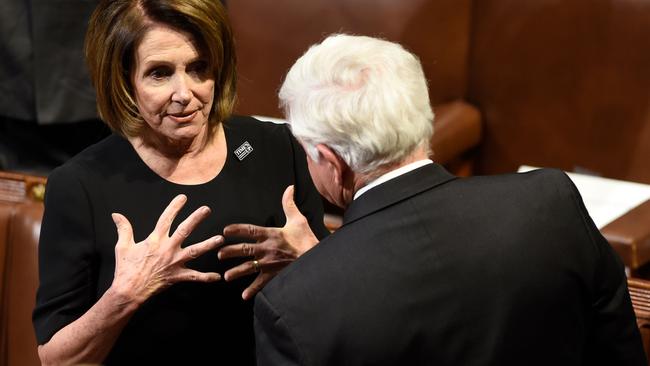
12.15pm: Supporters jostle for position
President Trump’s staunchest fans in Congress are lining up along the House aisle to be photographed shaking his hand.
About 30 House members and aides milled around the House floor two hours before the scheduled start of Trump’s State of the Union speech. Like any President, Trump was expected to walk down the centre aisle shaking hands on the way to the rostrum to deliver his address.
Republicans Louie Gohmert, Texas, and Mark Walker, North Carolina, had coveted aisle seats, ensuring TV time - and a potential Trump handshake - when the cameras follow the president into the chamber.
Other early arrivals included Republicans Peter King, New York, Billy Long, Missouri, Frank LoBiondo, New Jersey, and Aumua Amata Coleman Radewagen, the GOP delegate from American Samoa.
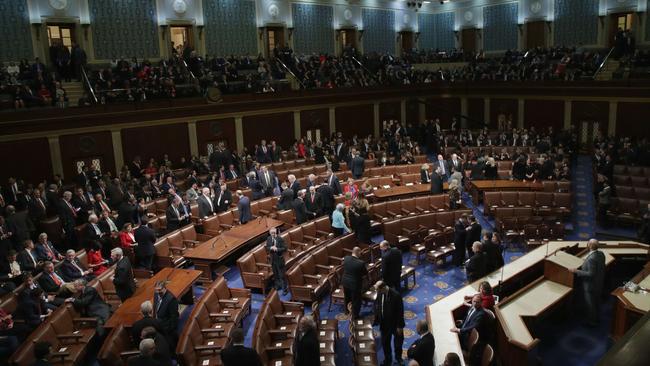
11.55am: Australian-style State of the Union
The President is expected to point to Australia as a blueprint in the key areas of immigration and infrastructure during his much-anticipated speech.
US Attorney General Jeff Sessions and other senior Trump administration officials have repeatedly praised Australia’s “merit-based” immigration system, rather than America’s current green card lottery and family chain migration. Mr Trump is also expected to propose a $US1.7 trillion infrastructure plan for roads, highways, bridges and airports.
Mr Trump’s budget director Mick Mulvaney, in an interview to preview the State of the Union speech, said America needed to fix the regulatory regime overseeing infrastructure.
He said it took two years to build a road or bridge in Australia and 10 years in America.
“You can look to the example of other countries,” Mr Mulvaney told CNN on Tuesday. “Countries that, I want to stress this, have more stringent environmental laws that we have.
“Canada and Australia come to mind.
“They are able to enforce those environmental laws and it only takes them two years to build a major piece of infrastructure such as a road or bridge. These are models we can put into place.
“If you’re not serious about changing the regulatory requirement then you’re not serious about solving infrastructure.”
Australian Ambassador to the US, Joe Hockey, has briefed Mr Trump’s chief economic adviser Gary Cohn and Vice-President Mike Pence about the asset recycling program he introduced as treasurer in the 2014 federal budget. Mr Mulvaney said Mr Trump’s infrastructure plan will involve “some of the most innovative financing ideas ever brought to (US) federal government”.
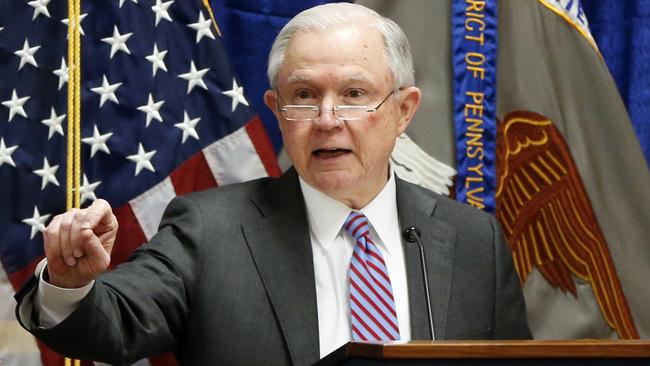
11.45am: ‘A safe, strong, proud America’
President Trump will say in his State of the Union address that the “war” on American energy and clean coal is over, the Wall Street Journal reports.
Excerpts published by the WSJ ahead of the speech reveal President Trump will say that he is committed to a “safe, strong and proud America”.
“We want every American to know the dignity of a hard day’s work; we want every child to be safe in their home at night, and we want every citizen to be proud of this land that we love.
“Just as I promised the American People from this podium 11 months ago, we enacted the biggest tax cuts and reform in American history.
“Our massive tax cuts provide tremendous relief for the Middle Class and small businesses.
Since we passed tax cuts, roughly 3 million workers have already gotten tax cut bonuses many of them thousands of dollars per worker.”
11.30am: Porn star denies Trump affair
An adult film star who previously alleged an extramarital affair with Donald Trump now says in a statement the affair never happened. A lawyer for porn actress Stormy Daniels has confirmed his client’s statement. Daniels’ real name is Stephanie Clifford.
Clifford has been on a publicity tour in recent weeks amid news of the alleged 2006 tryst with the president. She is scheduled to appear Tuesday on ABC’s “Jimmy Kimmel Live!” Her publicist hasn’t answered questions about the statement.
Clifford has sought to tell her story before, in 2011 and again during the 2016 presidential campaign.
The Wall Street Journal reported this month that Trump’s personal lawyer brokered a $130,000 payment to Clifford in October 2016 to keep her from publicly discussing it.
Trump’s lawyer has denied any affair.
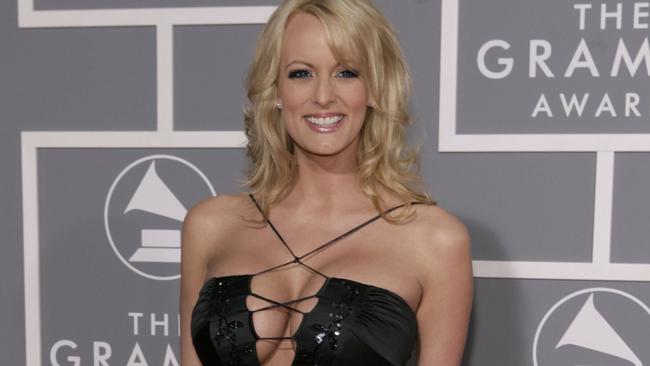
11.10am: Islamic State targeted
President Trump will warn that “much more” work remains in the war against the Islamic State group when he delivers his State of the Union address.
“The coalition to defeat (IS) has liberated almost 100 per cent of the territory once held by these killers in Iraq and Syria,” Trump will say in the address to Congress, according to excerpts released by the White House. “But there is much more work to be done.”
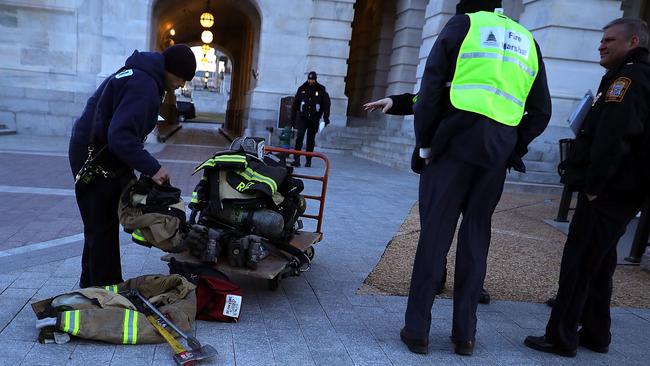
11am: President to call for unity
President Donald Trump will call for a “new American moment” will urge the nation to come together as a single “family” as he seeks to unite a deeply polarised nation in his State of the Union address.
According to excerpts released ahead of the prime-time address, the President will declare that there has “never been a better time to start living the American dream.”
He’s calling on lawmakers in both parties to join forces to modernise the nation’s crumbling infrastructure and revamp immigration policies to focus on “the best interests of American workers and American families.”
“I am extending an open hand to work with members of both parties, Democrats and Republicans, to protect our citizens, of every background, colour, and creed,” Trump said in the excerpts.
It’s unclear if Trump’s rhetoric will be matched by any real overtures to Democrats.
10.30am: Leadership requires ‘heart, soul’
What has President Donald Trump learned in his first year as president? That you have to lead with “heart.” That’s what Trump told network news anchors during a pre-State of the Union lunch.
Trump says, “You govern with all of the instincts of a businessperson, but you have to add much more heart and soul into your decisions than you would ever have even thought of before.” That’s according to excerpts released by the White House.
Trump also says issues like immigration would be “so simple” to solve if they were pure business matters, but he says he realises that “millions and millions of people” are affected by his actions.
He adds that “it’s much different, in that way, than I thought it would be.”
#SOTU pic.twitter.com/SPK3XyXWrX
— Dan Scavino Jr.🇺🇸 (@Scavino45) January 30, 2018
10am: Looking for a little publicity?
President Donald Trump’s re-election campaign is trying to raise cash from his first State of the Union speech and giving donors a taste of the spotlight. Those who contribute will have their names displayed under the livestream of the speech on the campaign’s website Tuesday night.
Trump’s middle son, Eric, says in a fundraising email that, “Even if you choose to only give $1, the proof of your support will send shockwaves around the world as they see every American who proudly stands behind our President.”
The government watchdog group Public Citizen is criticising the campaign for using the speech as a campaign fundraising event.
The group’s president, Robert Weissman, says Trump “is commercialising and corrupting yet another national institution.”
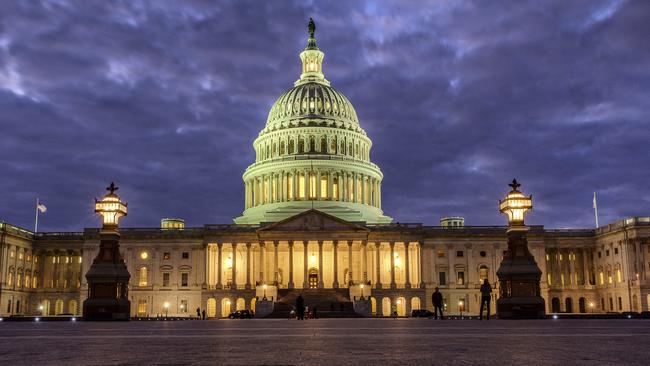
What we can expect
President Trump is looking to showcase the accomplishments of his first year in office, while setting the tone for the second. Aides say he plans to set aside his more combative tone for one of compromise, and to make an appeal beyond his hard-right base.
Beset by poor poll numbers and the grind of the Russia investigation, the President will look to reset his term, arguing that his tax cut and economic policies will benefit all Americans. The annual address is a big set piece for any President, a prime-time window to talk to millions of voters. Every word is reviewed, every presidential guest carefully chosen, every sentence rehearsed. The stakes are enormous for the 71-year-old, hoping to move past a turbulent first 12 months in office.
President’s guest list
The President may invite up to 24 guests to sit with first lady Melania Trump in her box. Among those invited to attend are an Ohio welder who will benefit from the President’s tax overhaul and the parents of two Long Island teenagers who were believed to be killed by MS-13, an international crime gang which originated in Los Angeles.
Other guests are rescuers who battled wildfires in California and flooding in Texas, as well as a Marine who re-enlisted after losing his legs and going blind from a roadside bomb.
Take two on hot-ticket item
Tickets to the event had to be reissued after a misprint. The tickets read, “Address to the Congress on the State of the Uniom.”
Lawmakers had fun with the glitch: “Looking forward to tomorrow’s State of the Uniom,” Senator Marco Rubio of Florida tweeted with a picture of the invite. Republican Raul Grijalva of Arizona used the glitch to jab at the secretary of education: “Just received my ticket for the State of the Union. Looks like (at)BetsyDeVosEd was in charge of spell checking... #SOTUniom”
The House Sergeant at Arms is responsible for printing and distributing the tickets. An official said a correction was immediately made and all but about a dozen tickets have been exchanged.
Looking forward to tomorrow’s State of the Uniom. pic.twitter.com/xdBUU3Pvo5
— Marco Rubio (@marcorubio) January 29, 2018
Trump’s tenure, by the numbers
Here’s a statistical deep dive into some key economic figures after year one of President Trump:
Stockmarket
As of Monday’s close, the Dow Jones Industrial Average is up 45 per cent since President Trump was elected and 34 per cent since he took office. The Dow closed at 18,332.74 on Election Day and 19,827.25 on Inauguration Day. The S&P 500, the market gauge that professionals attach more weight to, performed about the same: It’s up 33 per cent since the election and 26 per cent since the inauguration.
President Trump said at an economic conference in Switzerland last week that the market “is smashing one record after another,” adding more than $7 trillion in new wealth since his election. Left unsaid is that the market has done much better than experts initially anticipated because the U.S. economy has continued to gain strength. The rest of the world economy has also exceeded performance expectations.
Those factors, combined with low interest rates, economic stimulus elsewhere and tax cuts President Trump signed into law at the end of the year, have helped stocks surge.
Health insurance
Progress reducing the number of Americans without health insurance stalled toward the end of President Barack Obama’s term, and it may have slipped into reverse under President Trump, according to one major survey.
The Gallup-Sharecare Well-Being Index finds that the number of uninsured adults increased by about 3 million in 2017.
But the government’s National Health Interview Survey estimated that 28.8 million people were uninsured between January and June of 2017, not a statistically different change from 2016 and 2015. In the first six months of 2017, the uninsured rate was 9 per cent, the same share of the population as in 2016.
Crime
Early statistics released by the FBI last week show declines in some violent crimes and increases in one category for the first six months of 2017, compared with the same period in 2016.
Murder and manslaughter increased 1.5 per cent in the first six months of 2017 over the first six months of 2016. The number of rapes decreased 2.4 per cent, robbery offences fell 2.2 per cent and aggravated assaults were down 0.1 per cent, according to the bureau.
The report is based on information from 13,033 law enforcement agencies that submitted data to the FBI’s Uniform Crime Reporting Program for the first six months of 2016 and 2017.
401(K) retirement plans
The amount of money being squirrelled away in 401(k) and IRA plans has increased 10 per cent in the past year, aided by that strong stock performance, according to the financial firm Fidelity Investments. President Trump has said people often approach him to thank him for the boom in their retirement nest eggs. The average 401(k) balance was $99,000 in the third quarter of 2017, up 10 per cent from the average $90,900 balance in the same July-August-September period of 2016.
The average balance in individual retirement accounts, or IRAs, rose to $103,500 in the third quarter of 2017, up from $94,000 in 2016.
Military/security
President Trump has expanded America’s war-footing, both in the number of troops deployed to war zones and in their ability to conduct offensive operations. As his term wrapped up, President Barack Obama was withdrawing forces from Afghanistan as he eyed an end to the war. In a reversal, President Trump has approved sending in more troops and giving them greater authority to go after members of the Taliban and other insurgent groups.
U.S. forces in Afghanistan currently number around 14,000, a 75 per cent increase from the 8,400 forces there as of December 2016.
The Obama administration had capped the number of troops in Iraq at 5,262. Because of Iraqi government sensitivities, the U.S. continues to say publicly that roughly 5,200 troops are there, when the actual number is now about 7,000. Obama had capped the number of troops in Syria at 503. About 2,000 are there now.
Unemployment
More people are working or actively seeking employment. The unemployment rate was 4.8 per cent in January 2017, the month President Trump was sworn into office, according to the federal Bureau of Labor Statistics. The rate has fallen steadily since then to 4.1 per cent in October, where it remained through December, continuing a trend of falling unemployment that began under Obama. Obama took office at the depths of the Great Recession, when the economy was shedding hundreds of thousands of jobs every month.
The unemployment report for January 2018 will be released Friday. The economy added slightly more than 2 million jobs in President Trump’s first year, a figure that is close to the 2.2 million jobs created during Obama’s final year in office.
Race relations
More people think race relations have worsened since President Trump’s election in November 2016. Back then, 25 per cent of those surveyed by the Pew Research Center expressed optimism that having the politically inexperienced New York businessman in the Oval Office would improve relations between the races. By December 2017, the percentage who felt that way had sunk to 8 per cent, according to Pew. Forty-six per cent in the November 2016 survey said President Trump’s election would worsen relations. That figure grew to 60 per cent by last December. President Trump has weathered a number of racially charged controversies as a candidate and since taking office, including saying there were “very fine people” on both sides of a white supremacist protest and counterprotest in Charlottesville, Virginia, last summer. He most recently dismissed African countries by using a vulgarity that describes a filthy toilet.
National debt
In President Trump’s first year in office, the national debt grew by $546.4 billion. In 2016, Obama’s final year, the national debt grew by $1.01 trillion. The debt would have grown more in 2017 if not for the fact that the Trump administration is constrained by reaching the debt ceiling of $20.5 trillion. Treasury Secretary Steven Mnuchin has been using various accounting manoeuvres to keep Uncle Sam from going over the debt limit. Mnuchin will lose the ability to use these techniques in late February or early March, at which time lawmakers and the White House must agree on a plan to increase the borrowing limit so the government won’t default on its obligations.
Trade deficits
President Trump made America’s trade deficits with China and other countries a central tenet of his campaign, vowing to move toward trade that he deems fair and reciprocal to protect the U.S. from being taken advantage of financially. Within days of taking office in 2017, President Trump pulled the U.S. out of a sweeping trade pact with 11 Pacific Rim nations. He is renegotiating NAFTA, a decades-old agreement with Canada and Mexico, as well as a separate, bilateral trade pact with South Korea.
The deficit in goods and services was $513.6 billion from January through November 2017. That’s 11.6 per cent higher than the $460.2 billion deficit recorded for the same period in 2016, the final year of Obama’s term. The deficit for all of 2016 was $504.8 billion, and the 2017 figure already exceeds that with December’s total still to be counted.
The deficit in goods with China was $116.7 billion for the first 11 months of 2017, up 12.3 per cent from the same period in 2016.
With Mexico, the deficit was $65.7 billion, 9.6 per cent higher than the same period in 2016.
AP/AFP



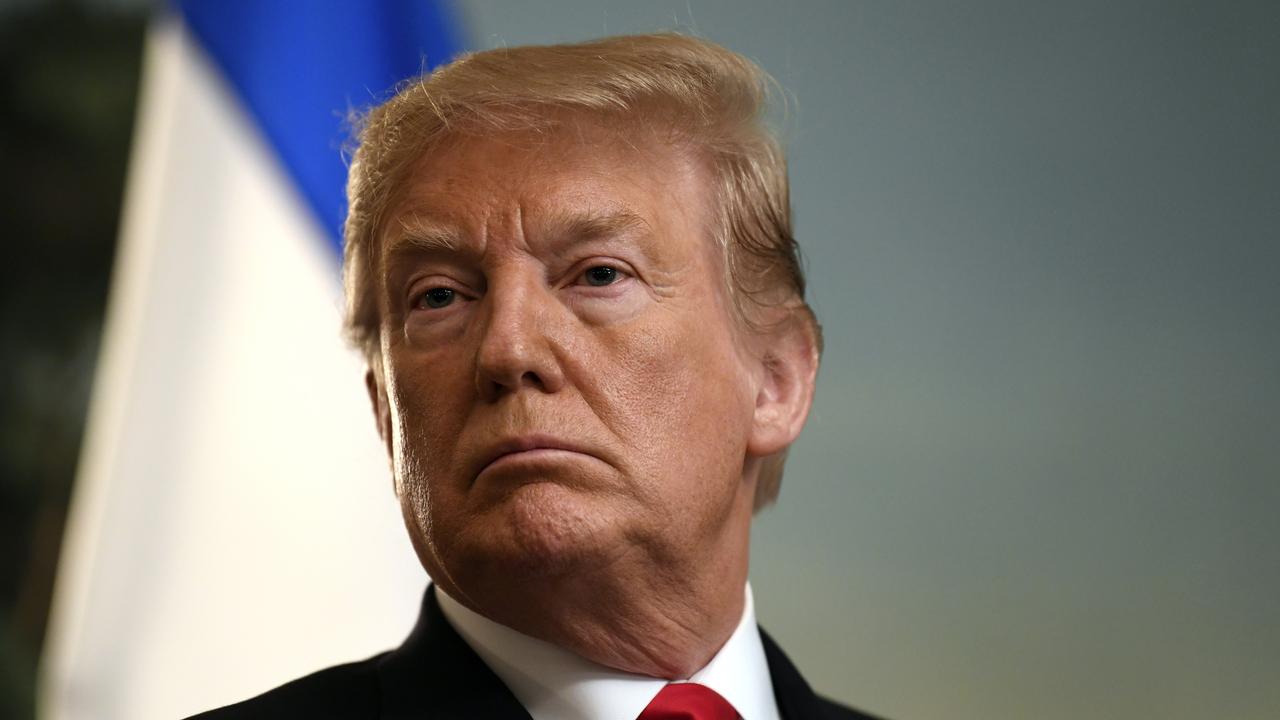
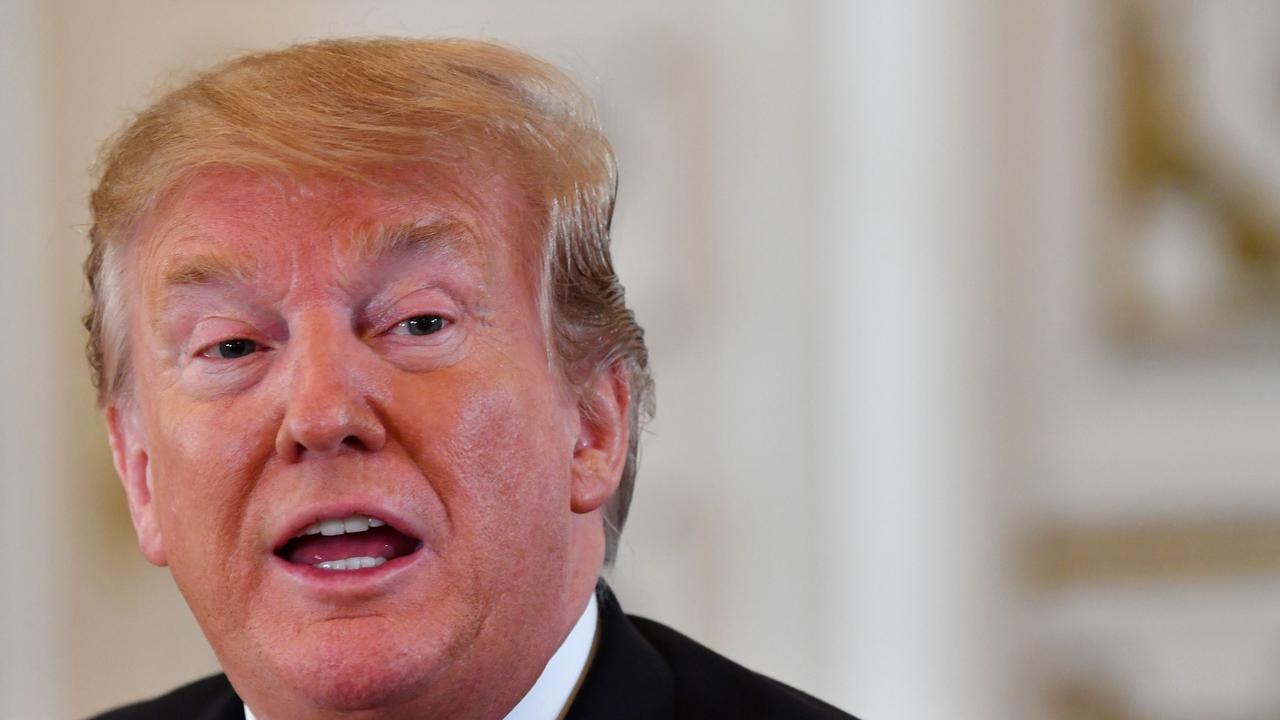
To join the conversation, please log in. Don't have an account? Register
Join the conversation, you are commenting as Logout